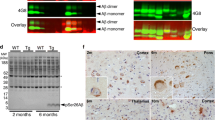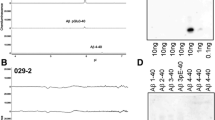Abstract
The progressive accumulation of extracellular amyloid plaques in the brain is a common hallmark of Alzheimer’s disease (AD). We recently identified a novel species of Aβ phosphorylated at serine residue 8 with increased propensity to form toxic aggregates as compared to non-phosphorylated species. The age-dependent analysis of Aβ depositions using novel monoclonal phosphorylation-state specific antibodies revealed that phosphorylated Aβ variants accumulate first inside of neurons in a mouse model of AD already at 2 month of age. At higher ages, phosphorylated Aβ is also abundantly detected in extracellular plaques. Besides a large overlap in the spatiotemporal deposition of phosphorylated and non-phosphorylated Aβ species, fractionized extraction of Aβ from brains revealed an increased accumulation of phosphorylated Aβ in oligomeric assemblies as compared to non-phosphorylated Aβ in vivo. Thus, phosphorylated Aβ could represent an important species in the formation and stabilization of neurotoxic aggregates, and might be targeted for AD therapy and diagnosis.





Similar content being viewed by others
Abbreviations
- AD:
-
Alzheimer’s disease
- Aβ:
-
Amyloid-β-peptide
- NFT:
-
Neurofibrillary tangles
- APP:
-
Amyloid precursor protein
- CTFs:
-
C-terminal fragments
- npAβ:
-
Non-phosphorylated Aβ
- pAβ:
-
Phosphorylated Aβ
- ELISA:
-
Enzyme-linked immunosorbent assay
- WB:
-
Western blotting
- IHC:
-
Immunohistochemistry
- BSA:
-
Bovine serum albumin
- PBS:
-
Phosphate buffered saline
- SDS:
-
Sodium dodecyl sulphate
- PAGE:
-
Polyacrylamide gel electrophoresis
- Fl-APP:
-
Full-length APP
References
Abramowski D, Rabe S, Upadhaya AR, Reichwald J, Danner S et al (2012) Transgenic expression of intraneuronal Abeta42 but not Abeta40 leads to cellular Abeta lesions, degeneration, and functional impairment without typical Alzheimer’s disease pathology. J Neurosci 32:1273–1283
Bayer TA, Wirths O (2010) Intracellular accumulation of amyloid-Beta—a predictor for synaptic dysfunction and neuron loss in Alzheimer’s disease. Front Aging Neurosci 2:8
Bayer TA, Wirths O (2011) Intraneuronal Abeta as a trigger for neuron loss: can this be translated into human pathology? Biochem Soc Trans 39:857–861
Billings LM, Oddo S, Green KN, McGaugh JL, LaFerla FM (2005) Intraneuronal Abeta causes the onset of early Alzheimer’s disease-related cognitive deficits in transgenic mice. Neuron 45:675–688
Casas C, Sergeant N, Itier JM, Blanchard V, Wirths O et al (2004) Massive CA1/2 neuronal loss with intraneuronal and N-terminal truncated Abeta42 accumulation in a novel Alzheimer transgenic model. Am J Pathol 165:1289–1300
Christensen DZ, Kraus SL, Flohr A, Cotel MC, Wirths O, Bayer TA (2008) Transient intraneuronal A beta rather than extracellular plaque pathology correlates with neuron loss in the frontal cortex of APP/PS1KI mice. Acta Neuropathol 116:647–655
Crowther DC, Kinghorn KJ, Miranda E, Page R, Curry JA et al (2005) Intraneuronal Abeta, non-amyloid aggregates and neurodegeneration in a Drosophila model of Alzheimer’s disease. Neuroscience 132:123–135
D’Andrea MR, Nagele RG, Wang HY, Peterson PA, Lee DH (2001) Evidence that neurones accumulating amyloid can undergo lysis to form amyloid plaques in Alzheimer’s disease. Histopathology 38:120–134
Dong J, Atwood CS, Anderson VE, Siedlak SL, Smith MA et al (2003) Metal binding and oxidation of amyloid-beta within isolated senile plaque cores: raman microscopic evidence. Biochemistry 42:2768–2773
Echeverria V, Ducatenzeiler A, Dowd E, Janne J, Grant SM et al (2004) Altered mitogen-activated protein kinase signaling, tau hyperphosphorylation and mild spatial learning dysfunction in transgenic rats expressing the beta-amyloid peptide intracellularly in hippocampal and cortical neurons. Neuroscience 129:583–592
Glenner GG, Wong CW (2012) Alzheimer’s disease: initial report of the purification and characterization of a novel cerebrovascular amyloid protein. 1984. Biochem Biophys Res Commun 425:534–539
Gouras GK, Almeida CG, Takahashi RH (2005) Intraneuronal Abeta accumulation and origin of plaques in Alzheimer’s disease. Neurobiol Aging 26:235–1244
Gouras GK, Tsai J, Naslund J, Vincent B, Edgar M et al (2000) Intraneuronal Abeta42 accumulation in human brain. Am J Pathol 156:15–20
Gouras GK, Willen K, Tampellini D (2012) Critical role of intraneuronal Abeta in Alzheimer’s disease: technical challenges in studying intracellular Abeta. Life Sci 91:1153–1158
Gyure KA, Durham R, Stewart WF, Smialek JE, Troncoso JC (2001) Intraneuronal abeta-amyloid precedes development of amyloid plaques in Down syndrome. Arch Pathol Lab Med 125:489–492
Hsia AY, Masliah E, McConlogue L, Yu GQ, Tatsuno G et al (1999) Plaque-independent disruption of neural circuits in Alzheimer’s disease mouse models. Proc Natl Acad Sci USA 96:3228–3233
Iwatsubo T, Saido TC, Mann DM, Lee VM, Trojanowski JQ (1996) Full-length amyloid-beta (1–42(43)) and amino-terminally modified and truncated amyloid-beta 42(43) deposit in diffuse plaques. Am J Pathol 149:1823–1830
Jawhar S, Wirths O, Bayer TA (2011) Pyroglutamate amyloid-beta (Abeta): a hatchet man in Alzheimer disease. J Biol Chem 286:38825–38832
Kumar S, Rezaei-Ghaleh N, Terwel D, Thal DR, Richard M et al (2011) Extracellular phosphorylation of the amyloid beta-peptide promotes formation of toxic aggregates during the pathogenesis of Alzheimer’s disease. EMBO J 30:2255–2265
Kumar S, Singh S, Hinze D, Josten M, Sahl HG et al (2012) Phosphorylation of amyloid-beta peptide at serine 8 attenuates its clearance via insulin-degrading and angiotensin-converting enzymes. J Biol Chem 287:8641–8651
Kumar S, Walter J (2011) Phosphorylation of amyloid beta (Abeta) peptides—a trigger for formation of toxic aggregates in Alzheimer’s disease. Aging (Albany NY) 3:803–812
Kummer MP, Hermes M, Delekarte A, Hammerschmidt T, Kumar S et al (2011) Nitration of tyrosine 10 critically enhances amyloid beta aggregation and plaque formation. Neuron 71:833–844
Kuo YM, Kokjohn TA, Beach TG, Sue LI, Brune D et al (2001) Comparative analysis of amyloid-beta chemical structure and amyloid plaque morphology of transgenic mouse and Alzheimer’s disease brains. J Biol Chem 276:12991–12998
Lansbury PT Jr (1997) Structural neurology: are seeds at the root of neuronal degeneration? Neuron 19:1151–1154
Li M, Chen L, Lee DH, Yu LC, Zhang Y (2007) The role of intracellular amyloid beta in Alzheimer’s disease. Prog Neurobiol 83:131–139
Lott IT (2012) Neurological phenotypes for down syndrome across the life span. Prog Brain Res 197:101–121
Masliah E, Sisk A, Mallory M, Mucke L, Schenk D, Games D (1996) Comparison of neurodegenerative pathology in transgenic mice overexpressing V717F beta-amyloid precursor protein and Alzheimer’s disease. J Neurosci 16:5795–5811
Masters CL, Simms G, Weinman NA, Multhaup G, McDonald BL, Beyreuther K (1985) Amyloid plaque core protein in Alzheimer disease and down syndrome. Proc Natl Acad Sci USA 82:4245–4249
Milton NG (2001) Phosphorylation of amyloid-beta at the serine 26 residue by human cdc2 kinase. NeuroReport 12:3839–3844
Milton NG (2005) Phosphorylated amyloid-beta: the toxic intermediate in alzheimer’s disease neurodegeneration. Subcell Biochem 38:381–402
Mori C, Spooner ET, Wisniewsk KE, Wisniewski TM, Yamaguch H et al (2002) Intraneuronal Abeta42 accumulation in down syndrome brain. Amyloid 9:88–102
Mori H, Ishii K, Tomiyama T, Furiya Y, Sahara N et al (1994) Racemization: its biological significance on neuropathogenesis of Alzheimer’s disease. Tohoku J Exp Med 174:251–262
Murakami K, Uno M, Masuda Y, Shimizu T, Shirasawa T, Irie K (2008) Isomerization and/or racemization at Asp23 of Abeta42 do not increase its aggregative ability, neurotoxicity, and radical productivity in vitro. Biochem Biophys Res Commun 366:745–751
Oakley H, Cole SL, Logan S, Maus E, Shao P et al (2006) Intraneuronal beta-amyloid aggregates, neurodegeneration, and neuron loss in transgenic mice with five familial Alzheimer’s disease mutations: potential factors in amyloid plaque formation. J Neurosci 26:10129–10140
Oddo S, Caccamo A, Shepherd JD, Murphy MP, Golde TE et al (2003) Triple-transgenic model of Alzheimer’s disease with plaques and tangles: intracellular Abeta and synaptic dysfunction. Neuron 39:409–421
Saido TC, Iwatsubo T, Mann DM, Shimada H, Ihara Y, Kawashima S (1995) Dominant and differential deposition of distinct beta-amyloid peptide species, A beta N3(pE), in senile plaques. Neuron 14:457–466
Saido TC, Yamao-Harigaya W, Iwatsubo T, Kawashima S (1996) Amino- and carboxyl-terminal heterogeneity of beta-amyloid peptides deposited in human brain. Neurosci Lett 215:173–176
Schilling S, Zeitschel U, Hoffmann T, Heiser U, Francke M et al (2008) Glutaminyl cyclase inhibition attenuates pyroglutamate Abeta and Alzheimer’s disease-like pathology. Nat Med 14:1106–1111
Selkoe DJ (2001) Alzheimer’s disease: genes, proteins, and therapy. Physiol Rev 81:741–766
Shimizu T, Watanabe A, Ogawara M, Mori H, Shirasawa T (2000) Isoaspartate formation and neurodegeneration in Alzheimer’s disease. Arch Biochem Biophys 381:225–234
Tam JH, Pasternak SH (2012) Amyloid and Alzheimer’s disease: inside and out. Can J Neurol Sci 39:286–298
Tekirian TL, Saido TC, Markesbery WR, Russell MJ, Wekstein DR et al (1998) N-terminal heterogeneity of parenchymal and cerebrovascular Abeta deposits. J Neuropathol Exp Neurol 57:76–94
Teplow DB (1998) Structural and kinetic features of amyloid beta-protein fibrillogenesis. Amyloid 5:121–142
Tomiyama T, Asano S, Furiya Y, Shirasawa T, Endo N, Mori H (1994) Racemization of Asp23 residue affects the aggregation properties of Alzheimer amyloid beta protein analogues. J Biol Chem 269:10205–10208
Walker LC, Rosen RF, LeVine H III (2008) Diversity of Abeta deposits in the aged brain: a window on molecular heterogeneity? Rom J Morphol Embryol 49:5–11
Walter J, Kaether C, Steiner H, Haass C (2001) The cell biology of Alzheimer’s disease: uncovering the secrets of secretases. Curr Opin Neurobiol 11:585–590
Wertkin AM, Turner RS, Pleasure SJ, Golde TE, Younkin SG et al (1993) Human neurons derived from a teratocarcinoma cell line express solely the 695-amino acid amyloid precursor protein and produce intracellular beta-amyloid or A4 peptides. Proc Natl Acad Sci USA 90:9513–9517
Winton MJ, Lee EB, Sun E, Wong MM, Leight S et al (2011) Intraneuronal APP, not free Abeta peptides in 3xTg-AD mice: implications for tau versus Abeta-mediated Alzheimer neurodegeneration. J Neurosci 31:7691–7699
Wirths O, Bayer TA (2012) Intraneuronal Abeta accumulation and neurodegeneration: lessons from transgenic models. Life Sci 91:1148–1152
Wirths O, Multhaup G, Czech C, Blanchard V, Moussaoui S et al (2001) Intraneuronal Abeta accumulation precedes plaque formation in beta-amyloid precursor protein and presenilin-1 double-transgenic mice. Neurosci Lett 306:116–120
Youmans KL, Tai LM, Kanekiyo T, Stine WB Jr, Michon SC et al (2012) Intraneuronal Abeta detection in 5xFAD mice by a new Abeta-specific antibody. Mol Neurodegener 7:8
Acknowledgments
We thank Dr. G. Multhaup for providing rabbit polyclonal 692 antibodies specific against human Aß. We also thank Drs. M.T. Heneka and M.P. Kummer for providing nitrated Aß. This study was supported by the Deutsche Forschungsgemeinschaft (DFG) to J.W. (WA1477/6, SFB645, and KFo177) and to S.K. by the Alzheimer Forschung Initiative e.V. (AFI # 12854).
Author information
Authors and Affiliations
Corresponding author
Electronic supplementary material
Below is the link to the electronic supplementary material.
Rights and permissions
About this article
Cite this article
Kumar, S., Wirths, O., Theil, S. et al. Early intraneuronal accumulation and increased aggregation of phosphorylated Abeta in a mouse model of Alzheimer’s disease. Acta Neuropathol 125, 699–709 (2013). https://doi.org/10.1007/s00401-013-1107-8
Received:
Revised:
Accepted:
Published:
Issue Date:
DOI: https://doi.org/10.1007/s00401-013-1107-8




